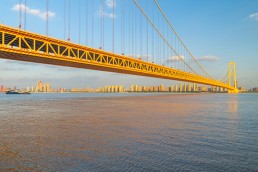© Pechristener, Wikimedia CommonsGrand Pont Suspendu 1834
Grand Pont Suspendu 1834
The Bridge
The Grand Pont Suspendu, at Fribourg in Switzerland, was built in 1834 and removed in 1923. It is fitting that this bridge is included in a collection of the world’s greatest suspension bridges because Joseph Chaley’s design is historically important in setting a new standard. He was inspired by French engineer Louis Vicat to develop the use of main suspension cables. At Fribourg the four main cables were made up of over 1,000 individual wires and ‘spun’ on site. This enabled the construction of long cables at less cost than previous methods and achieved a world record clear span of 273m.
This method has become known as aerial spinning. John A Roebling developed it further for use on the Brooklyn Bridge, and Bill Brown consulted on projects throughout the world with his cable erection refinements cutting construction time and saving project costs.
Grand Pont Suspendu
Historically-important span in Fribourg
Key Facts
Opened in 1834 and removed in 1923
Joseph Chaley’s design pioneered the use of individual wires ‘spun’ on site to form the main suspension cables
Location
Fribourg, Switzerland
Crossed the Sarine River until 1923
Designers / Engineers
Joseph Chaley
Description
Suspension bridge
273m main span
Challenge
To develop the four main cables each from 1,056 individual iron wires
Construction
Began in 1832
Opened in 1834
Removed in 1923































































